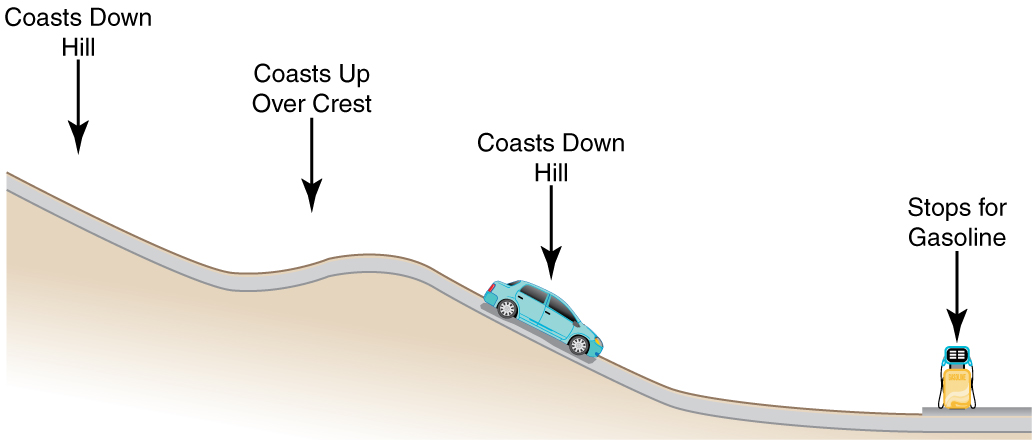| << Chapter < Page | Chapter >> Page > |
A child has two red wagons, with the rear one tied to the front by a stretchy rope (a spring). If the child pulls on the front wagon, the ____ increases.
(c)
A child has two red wagons, with the rear one tied to the front by a stretchy rope (a spring). If the child pulls on the front wagon, the energy stored in the system increases. How do the relative amounts of potential and kinetic energy in this system change over time?
Which of the following are closed systems?
(c), (d)
Describe a real-world example of a closed system.
A 5.0-kg rock falls off of a 10 m cliff. If air resistance exerts a force of 10 N, what is the kinetic energy when the rock hits the ground?
(a)
Hydroelectricity is generated by storing water behind a dam, and then letting some of it run through generators in the dam to turn them. If the system is the water, what is the environment that is doing work on it? If a dam has water 100 m deep behind it, how much energy was generated if 10,000 kg of water exited the dam at 2.0 m/s?
Before railroads were invented, goods often traveled along canals, with mules pulling barges from the bank. If a mule is exerting a 1200 N force for 10 km, and the rope connecting the mule to the barge is at a 20 degree angle from the direction of travel, how much work did the mule do on the barge?
(b)
Describe an instance today in which you did work, by the scientific definition. Then calculate how much work you did in that instance, showing your work.
Consider the following scenario. A car for which friction is not negligible accelerates from rest down a hill, running out of gasoline after a short distance. The driver lets the car coast farther down the hill, then up and over a small crest. He then coasts down that hill into a gas station, where he brakes to a stop and fills the tank with gasoline. Identify the forms of energy the car has, and how they are changed and transferred in this series of events. (See [link] .)

Describe the energy transfers and transformations for a javelin, starting from the point at which an athlete picks up the javelin and ending when the javelin is stuck into the ground after being thrown.
Do devices with efficiencies of less than one violate the law of conservation of energy? Explain.
List four different forms or types of energy. Give one example of a conversion from each of these forms to another form.
List the energy conversions that occur when riding a bicycle.
Using values from [link] , how many DNA molecules could be broken by the energy carried by a single electron in the beam of an old-fashioned TV tube? (These electrons were not dangerous in themselves, but they did create dangerous x rays. Later model tube TVs had shielding that absorbed x rays before they escaped and exposed viewers.)
Using energy considerations and assuming negligible air resistance, show that a rock thrown from a bridge 20.0 m above water with an initial speed of 15.0 m/s strikes the water with a speed of 24.8 m/s independent of the direction thrown.
Equating and , we obtain
If the energy in fusion bombs were used to supply the energy needs of the world, how many of the 9-megaton variety would be needed for a year’s supply of energy (using data from [link] )? This is not as far-fetched as it may sound—there are thousands of nuclear bombs, and their energy can be trapped in underground explosions and converted to electricity, as natural geothermal energy is.
(a) Use of hydrogen fusion to supply energy is a dream that may be realized in the next century. Fusion would be a relatively clean and almost limitless supply of energy, as can be seen from [link] . To illustrate this, calculate how many years the present energy needs of the world could be supplied by one millionth of the oceans’ hydrogen fusion energy. (b) How does this time compare with historically significant events, such as the duration of stable economic systems?
(a)
(b) This is much, much longer than human time scales.

Notification Switch
Would you like to follow the 'College physics for ap® courses' conversation and receive update notifications?